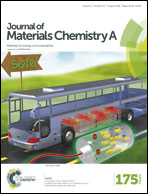Understanding the advantage of hexagonal WO3 as an efficient photoanode for solar water splitting: a first-principles perspective†
Abstract
Polycrystalline WO3 has been suggested as an alternative photoanode material for the water splitting reaction. However, the band gap and band edge positions of the most commonly used γ-monoclinic WO3 phase are found to be not optimal for effective water oxidation. In this work, by using first-principles density-functional theory calculations with an ab initio thermodynamic model, we demonstrate the potential advantage of using h-WO3 (and its surfaces) over the larger band gap γ-WO3 phase for the anode in water splitting. Notably, after addressing the relative thermodynamic stability of the various h-WO3 surfaces, we carefully quantify and compare the electronic band structure of these two bulk phases of WO3 (using their valence and conduction band edges as descriptors). We then provide a simple perspective as to illustrate how the surface band edges of h-WO3 match up with the redox potential of water and other possible cathode materials.


 Please wait while we load your content...
Please wait while we load your content...